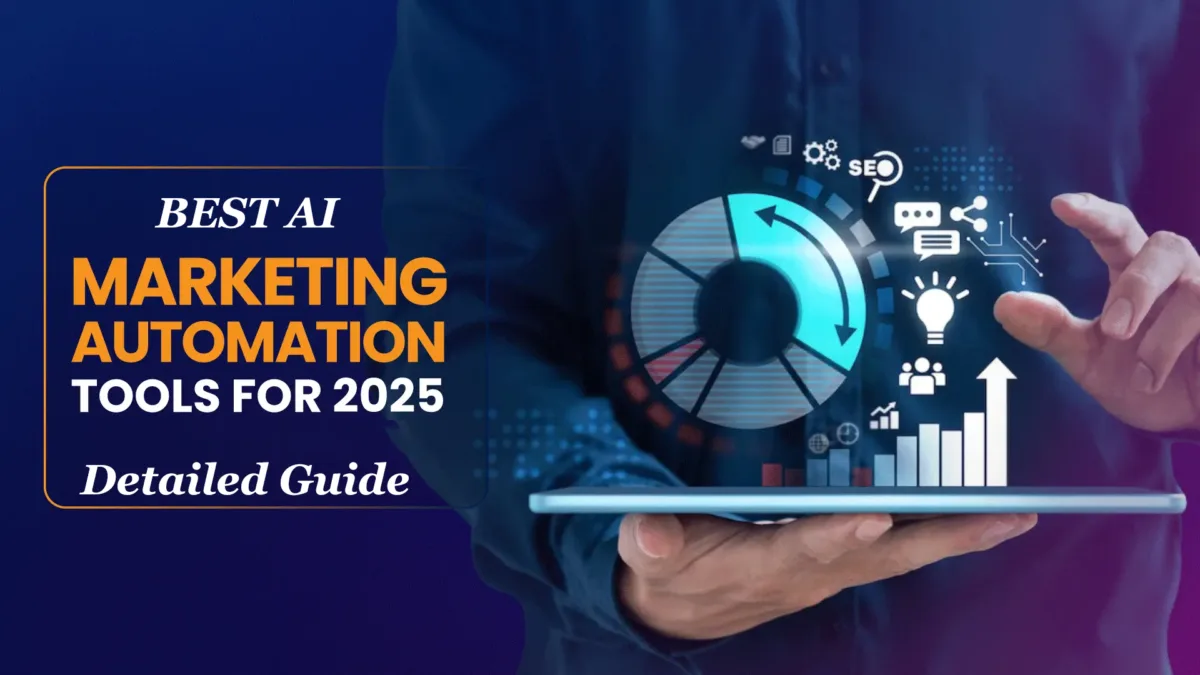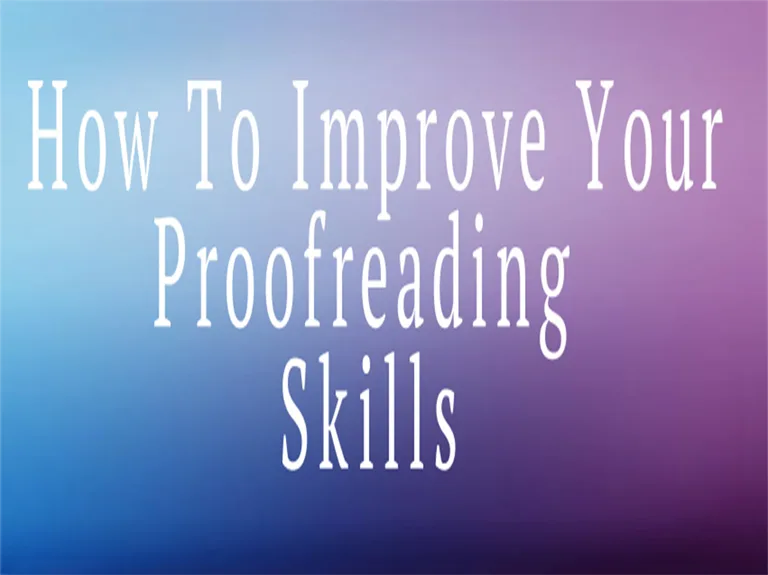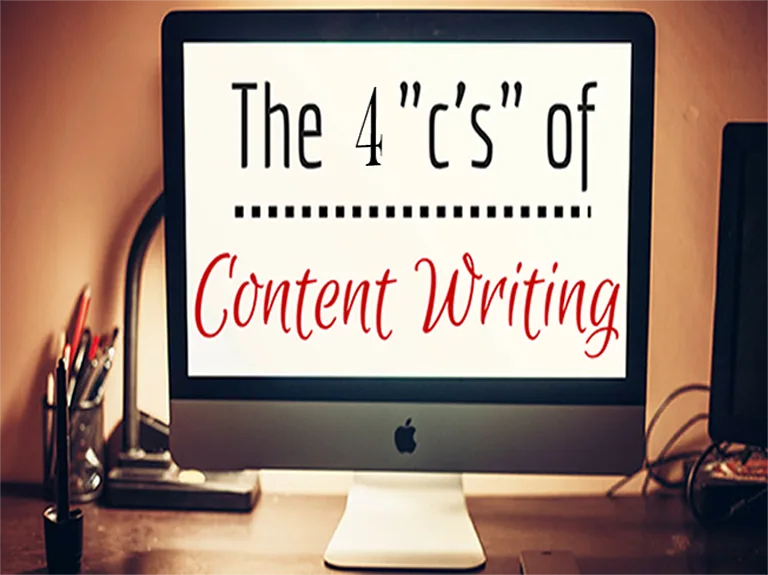Remember when you had to manually segment your email lists and send the same generic message to thousands of subscribers? Those days are long gone. AI marketing automation tools have transformed how we connect with customers, and the results speak for themselves. According to HubSpot’s 2025 State of Marketing report, 1 in 4/5 marketers plan to use AI to turn text-based content into multimedia campaigns and create AI agents to automate marketing workflows from strategy to execution.
But here’s what caught my attention: Companies using AI-powered marketing automation see an average 451% increase in qualified leads compared to traditional methods as per Marketo.
Having spent a decade in the industry and having witnessed this transformation firsthand, I can tell you that AI marketing automation isn’t just another buzzy trend – it’s becoming the foundation of successful marketing strategies.
Whether you’re a small business owner juggling multiple responsibilities or a marketing director at a Fortune 500 company, understanding how to leverage these tools effectively can make or break your marketing success. So, without further ado, let’s get started.
What Exactly is AI Marketing Automation?
Let’s cut through the jargon – AI marketing automation combines artificial intelligence technologies, like machine learning, predictive analytics, and natural language processing, with traditional marketing automation platforms to create smarter, more personalized customer experiences.
Think of it this way: Traditional marketing automation is like having a very organized assistant who follows your predetermined rules. AI marketing automation, on the contrary, is like having a brilliant strategist who learns from every interaction, predicts customer behavior, and optimizes campaigns in real-time.
The Key Components That Make AI Marketing Automation Work
- Machine Learning Algorithms: These continuously analyze customer data to identify patterns and predict future behaviors. For instance, they can determine which customers are most likely to purchase in the next 30 days.
- Predictive Analytics: This technology forecasts customer actions based on historical data. McKinsey’s research shows that companies using predictive analytics in marketing see 10-20% increases in marketing ROI.
- Natural Language Processing: This enables chatbots and content personalization engines to understand and respond to customer inquiries naturally.
- Real-Time Decision Making: AI systems can instantly decide which email to send, which product to recommend, or which ad to display based on current customer behavior.
Why AI Marketing Automation Matters More in 2025?
The marketing landscape has become incredibly complex. Today’s consumers interact with brands across multiple touchpoints – social media, email, websites, mobile apps, and physical stores. Managing these interactions manually is not just difficult; it’s impossible at scale.
Consider this scenario: A customer browses your website, adds items to their cart but doesn’t purchase, then engages with your social media post, and finally opens your email three days later. An AI-powered system can connect these dots instantly and trigger a personalized email with a discount for the exact items they viewed, increasing the likelihood of conversion by up to 35% according to data from Accenture’s Digital Marketing Performance study.
The Business Impact: Numbers That Matter
Deloitte’s 2024 Marketing Technology Report reveals some compelling statistics:
- Revenue Growth: Companies using AI marketing automation report 6.2x higher revenue growth rates
- Cost Reduction: Marketing costs decrease by an average of 28% when AI automation is implemented effectively
- Time Savings: Marketing teams save 12-15 hours per week on routine tasks
- Personalization Scale: Brands can deliver personalized experiences to 10x more customers without proportional increases in staff
These aren’t just impressive numbers – they represent real business transformation. Take the case of a mid-sized e-commerce company that implemented AI marketing automation tools and saw their email open rates jump from 18% to 34% within six months, while simultaneously reducing their marketing team’s workload.
Top AI Marketing Automation Platforms for 2025
Choosing the right platform can feel overwhelming with dozens of options available in the market and all with amazing features. So, after analyzing them one by one based on their extensive feature list, customer feedback, and industry adoption rates, here are a few platforms that I recommend:
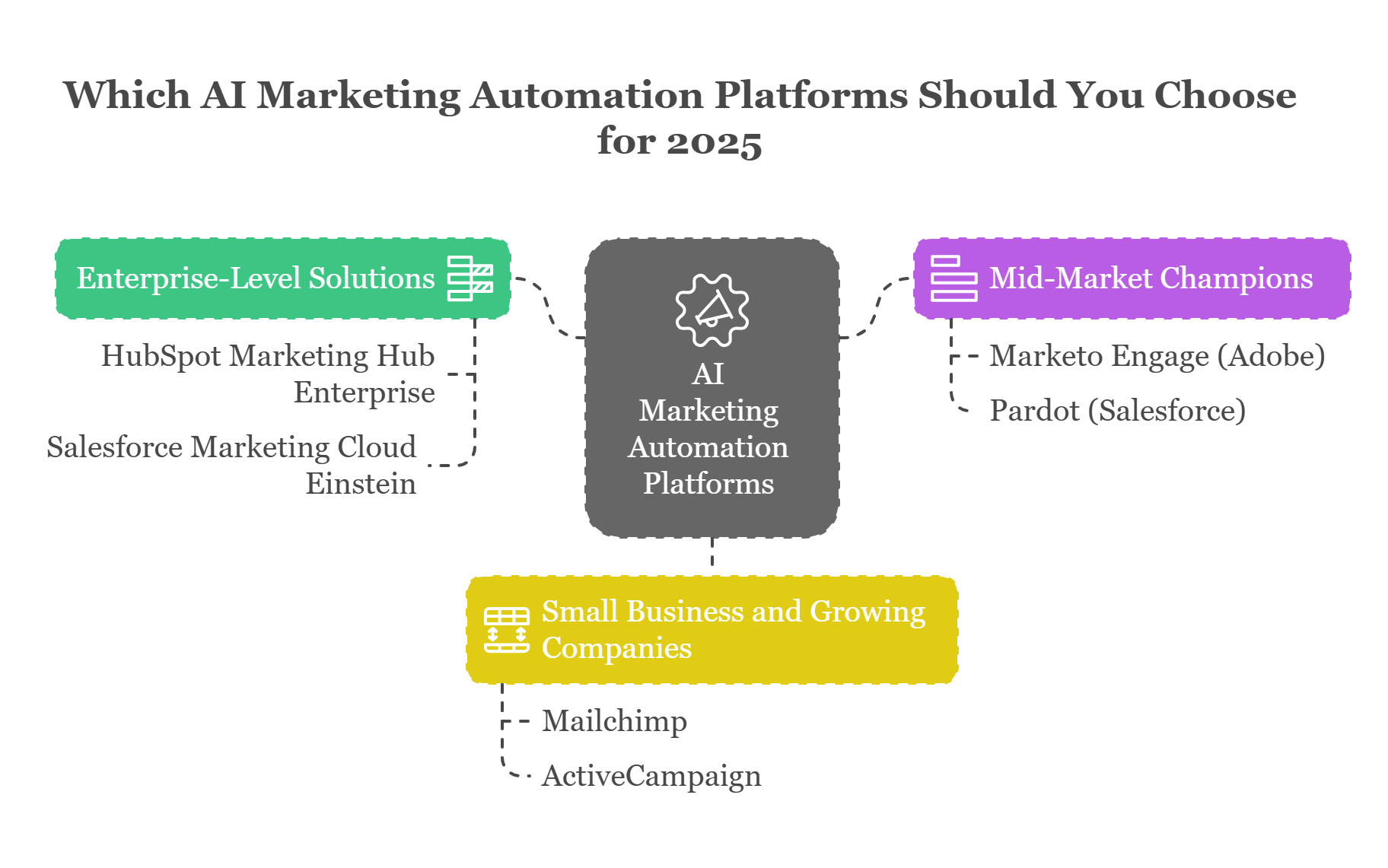
Enterprise-Level Solutions
HubSpot Marketing Hub Enterprise – HubSpot’s AI-powered features include predictive lead scoring, content optimization suggestions, and automated campaign optimization. Their machine learning algorithms analyze millions of data points to recommend the best times to send emails and which content resonates most with specific audience segments.
- Best for: Mid to large enterprises with complex sales funnels
- Pricing: Starting at $3,600/month
- Key AI Features: Predictive lead scoring, content optimization, conversation intelligence
Salesforce Marketing Cloud Einstein – Einstein AI integrates across all Salesforce products, providing predictive analytics, automated content creation, and intelligent customer journey optimization. PwC’s case study with a retail client showed 40% improvement in campaign performance after implementing Einstein.
- Best for: Large enterprises already using the Salesforce ecosystem
- Pricing: Custom pricing starting around $4,000/month
- Key AI Features: Predictive content, automated journey optimization, smart segmentation
Mid-Market Champions
Marketo Engage (Adobe) – Adobe’s AI technology, Sensei, powers advanced audience segmentation and predictive content recommendations. The platform excels at B2B marketing automation with sophisticated lead-nurturing capabilities.
- Best for: B2B companies with complex buyer journeys
- Pricing: Starting at $1,195/month
- Key AI Features: Predictive audiences, content personalization, automated A/B testing
Pardot (Salesforce) – Designed specifically for B2B marketing, Pardot’s AI capabilities include lead scoring, automated email optimization, and intelligent campaign attribution.
- Best for: B2B organizations focused on lead generation
- Pricing: Starting at $1,250/month
- Key AI Features: Einstein lead scoring, automated nurturing, ROI reporting
Small Business and Growing Companies
Mailchimp – Its AI features include predictive insights, automated product recommendations, and smart segmentation. Their “Customer Journey Builder” uses machine learning to optimize email timing and content.
- Best for: Small to medium businesses and e-commerce
- Pricing: AI features available from $299/month
- Key AI Features: Predictive insights, automated product recommendations, send time optimization
ActiveCampaign – Known for its user-friendly interface, ActiveCampaign offers AI-powered automation workflows, predictive content, and smart segmentation that rivals enterprise-level platforms.
- Best for: Growing businesses needing sophisticated automation without complexity
- Pricing: AI features from $187/month
- Key AI Features: Predictive sending, automated split testing, machine learning segmentation
Step-by-Step Implementation Guide: From Setup to Success
Implementing AI marketing automation tools successfully requires strategic planning. Here’s the proven framework that I’ve seen work across different industries and company sizes:
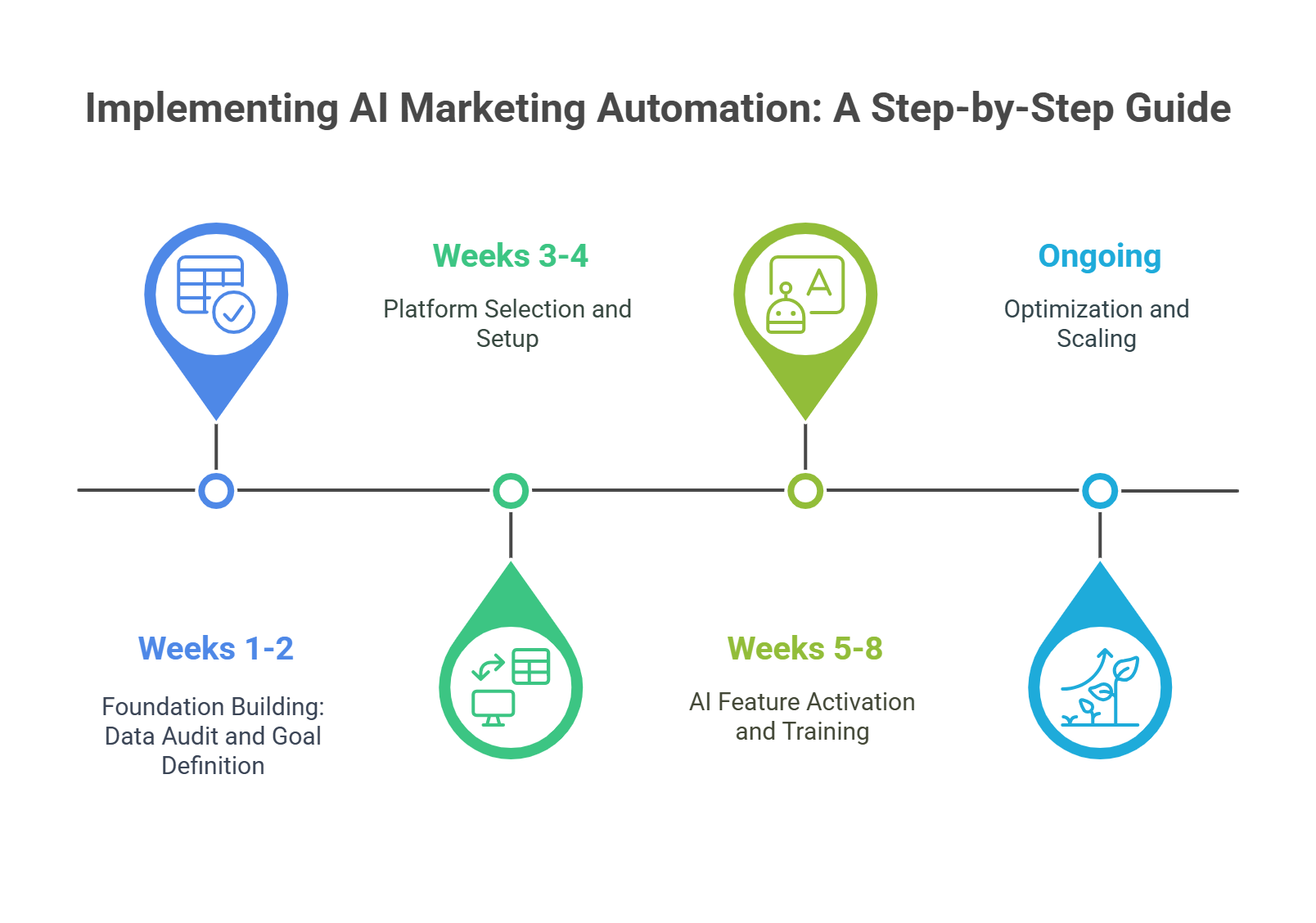
Phase 1: Foundation Building (Weeks 1-2)
Data Audit and Clean-Up – Your AI is only as good as your data. Start by auditing your existing customer data for completeness, accuracy, and consistency. EY’s Digital Marketing Assessment framework suggests focusing on these key data points:
- Customer demographics and firmographics
- Behavioral data (website interactions, email engagement, purchase history)
- Preference data (communication preferences, product interests)
- Lifecycle stage information
Goal Definition and KPI Selection – Define specific, measurable objectives. Instead of “improve marketing performance,” aim for “increase email click-through rates by 25% and reduce customer acquisition cost by 15% within six months.”
Phase 2: Platform Selection and Setup (Weeks 3-4)
Choosing Your Platform – Consider these factors when selecting your AI marketing automation tool and/or platform:
- Integration capabilities: How well does it connect with your existing tech stack?
- Scalability: Can it grow with your business needs?
- Learning curve: How quickly can your team become proficient?
- Support and training: What resources are available for implementation and ongoing use?
Initial Configuration – Start with basic automation workflows before implementing advanced AI features. This allows your team to get comfortable with the platform while the AI algorithms begin learning from your data.
Phase 3: AI Feature Activation and Training (Weeks 5-8)
Data Integration and AI Training – Connect all relevant data sources and allow the AI algorithms time to learn your customer patterns. Most platforms require 4-6 weeks of data collection before their predictive models become accurate.
Progressive Feature Rollout – Implement AI features gradually:
- Week 5-6: Activate predictive lead scoring and basic segmentation
- Week 7: Enable automated send time optimization and content recommendations
- Week 8: Launch predictive analytics and advanced personalization
Phase 4: Optimization and Scaling (Ongoing)
Continuous Monitoring and Adjustment – AI marketing automation tools and platforms require ongoing optimization. So, if you’re performing this activity at your enterprise, monitor these key metrics weekly:
- Algorithm Performance: Are predictions becoming more accurate over time?
- Campaign Effectiveness: How are AI-optimized campaigns performing compared to manual ones?
- Customer Engagement: Are personalization efforts improving customer interactions?
- ROI Metrics: Is the investment in AI automation generating positive returns?
Real-World Success Stories: AI Marketing Automation in Action
Case Study 1: E-commerce Revenue Transformation
A mid-sized fashion retailer implemented AI marketing automation and achieved remarkable results within eight months. By using predictive analytics to identify customers likely to make repeat purchases and AI-powered product recommendations, they saw:
- 67% increase in email revenue
- 43% improvement in customer lifetime value
- 28% reduction in cart abandonment rates
- 35% increase in average order value
The key was their approach to personalization. Instead of broad demographic segments, their AI system created micro-segments based on browsing behavior, purchase patterns, and engagement preferences.
Case Study 2: B2B Lead Generation Success
A technology consulting firm struggled with lead qualification and nurturing. After implementing AI marketing automation, they transformed their sales process:
Before AI Automation:
- The sales team spent 60% of its time on unqualified leads
- Average deal closure time: 9 months
- Lead-to-customer conversion rate: 2.3%
After AI Implementation:
- Sales focus shifted to the top 20% of AI-scored leads
- Average deal closure time: 5.5 months
- Lead-to-customer conversion rate: 7.8%
- Overall sales productivity increased by 45%
The AI system analyzed over 50 data points for each lead, including website behavior, content engagement, company information, and interaction patterns to create predictive lead scores.
Case Study 3: Customer Retention Breakthrough
A SaaS company used AI marketing automation tools to combat churn. Their predictive model identified customers at risk of canceling their subscriptions 45 days before they typically would churn, allowing for proactive intervention:
- Churn rate reduced from 8.2% to 4.7%
- Customer lifetime value increased by 34%
- Retention campaign ROI: 12:1
- Customer satisfaction scores improved by 28%
Their AI system triggered personalized retention campaigns including targeted content, special offers, and proactive customer success outreach based on individual risk factors.
Measuring ROI: How to Track AI Marketing Automation Success
One of the most common questions I hear around is –
“How do we know if our AI marketing automation tools investment is paying off?”
The answer is simple – You must track the right metrics and understand both direct and indirect returns.
Primary ROI Metrics
Revenue Attribution – Track revenue directly generated by AI-powered campaigns versus traditional marketing efforts. Most platforms provide attribution reporting, but ensure you’re also measuring:
- Direct campaign revenue: Sales directly attributed to AI-optimized campaigns
- Influenced revenue: Sales where AI-powered touchpoints played a role in the customer journey
- Lifetime value impact: Long-term revenue changes from improved customer experiences
Cost Efficiency Gains – Calculate savings from automation and improved targeting:
- Time saved: Hours saved on manual tasks (multiply by average hourly cost)
- Media efficiency: Improved ad targeting to minimize cost per acquisition
- Resource optimization: Reduced need for additional marketing personnel
Secondary Success Indicators
Engagement Quality Improvements – Start monitoring these engagement metrics for signs of AI effectiveness:
- Email open rates and click-through rates (CTRs)
- Website engagement time and pages per session
- Social media engagement rates and reach
- Content consumption patterns and preferences
Operational Efficiency Metrics – You must also track improvements in marketing operations via:
- Campaign setup time: How quickly can new campaigns be launched?
- Personalization scale: How many personalized experiences can you deliver?
- Response time: How quickly do you respond to customer behaviors?
- Data accuracy: Improvement in data quality and customer insights
P.S.: KPMG’s Marketing ROI study suggests that companies typically see positive ROI from AI marketing automation within 6-9 months, with full benefits realized within 12-18 months.
Common Challenges and How to Overcome Them
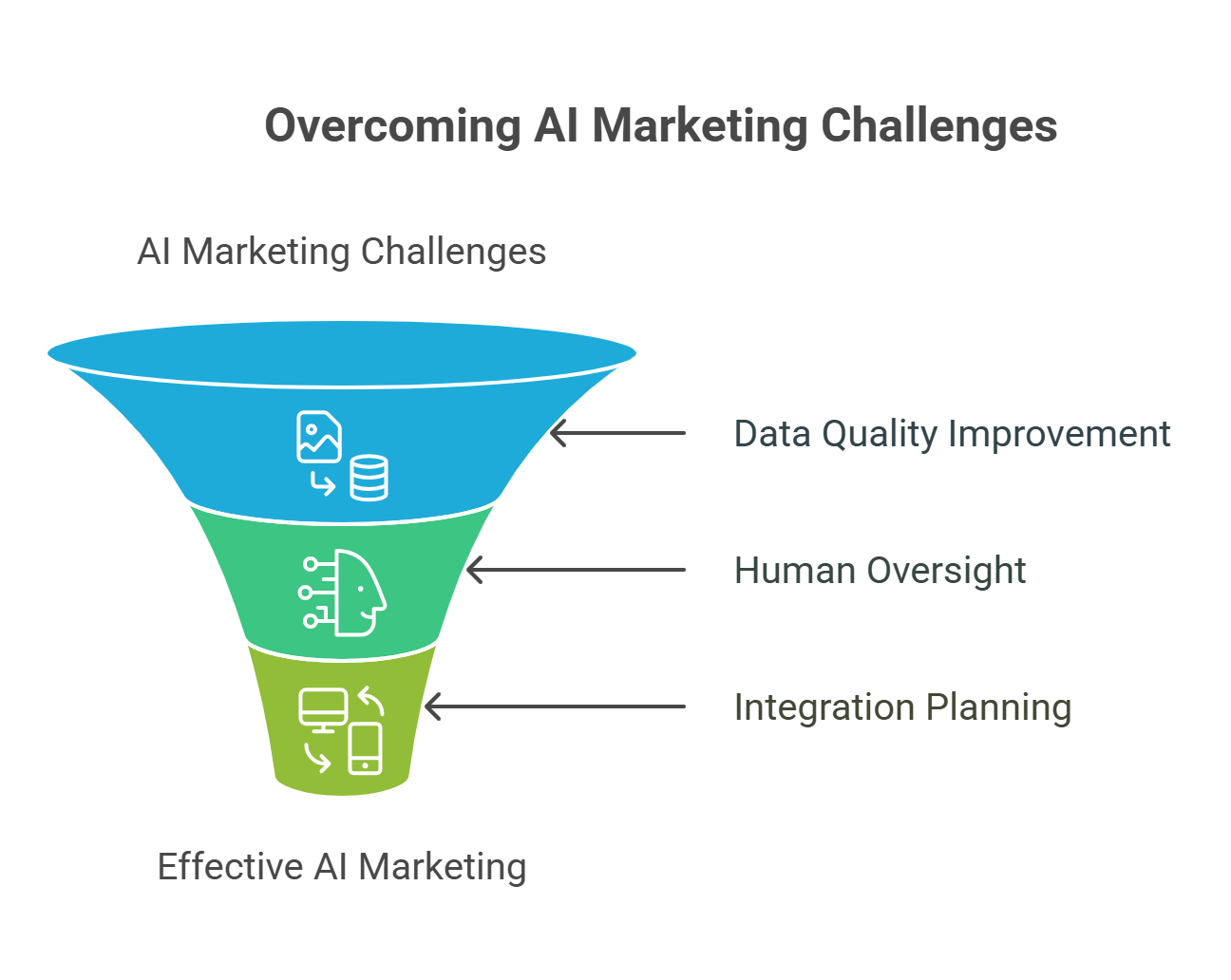
Data Quality Issues
The Challenge: AI algorithms require high-quality, consistent data to function effectively. Many companies struggle with incomplete customer profiles, duplicate records, and inconsistent data formats.
The Solution: Implement a data governance strategy before launching AI automation. This includes:
- Regular data audits and cleaning processes
- Standardized data collection procedures
- Integration protocols for new data sources
- Staff training on data quality importance
Over-Reliance on Automation
The Challenge: Some marketers infuse AI automation marketing tools and then step back completely, expecting the technology to handle everything independently. But that never happens.
The Solution: Maintain human oversight and creative input. AI excels at optimization and personalization, but you still need a human for:
- Strategic decision making
- Creative campaign concepts
- Brand voice and messaging
- Complex customer service situations
Integration Complexity
The Challenge: Connecting AI marketing automation platforms with existing systems (CRM, e-commerce, analytics tools) can be technically challenging.
The Solution: Plan integration carefully and consider working with implementation specialists. Focus on:
- Identifying all necessary integrations upfront
- Testing connections thoroughly before full deployment
- Having technical support readily available during implementation
- Training team members on troubleshooting common integration issues
The Future of AI Marketing Automation: What’s Coming Next
The AI marketing automation landscape continues evolving rapidly. Based on current technology trends and industry developments, here’s what we can expect:
Advanced Personalization Capabilities
- Hyper-Personalization at Scale – Future AI systems will create unique experiences for each customer using real-time data from multiple sources. Imagine emails that adjust content, timing, and offers based on current weather, recent purchases, social media activity, and even mood indicators from wearable devices.
- Voice and Conversational AI Integration – As voice search and smart speakers become more prevalent, AI marketing automation will incorporate voice interaction data and optimize for voice-based customer journeys.
Predictive Customer Experience
- Anticipatory Marketing AI will predict customer needs before customers realize them themselves. For example, a fitness brand’s AI might detect that a customer’s workout routine is changing and proactively suggest new products or content.
- Cross-Channel Journey Optimization Future platforms will optimize entire customer journeys across all touchpoints simultaneously, not just individual campaigns or channels.
Privacy-First AI Solutions
With increasing privacy regulations and the deprecation of third-party cookies, AI marketing automation tools will subsequently evolve to:
- Rely more heavily on first-party data and zero-party data
- Provide effective personalization while maintaining customer privacy
- Use federated learning and other privacy-preserving AI techniques
Getting Started: Your AI Marketing Automation Action Plan
Are you ready to transform your marketing with AI automation? Here’s your practical next-steps guide:
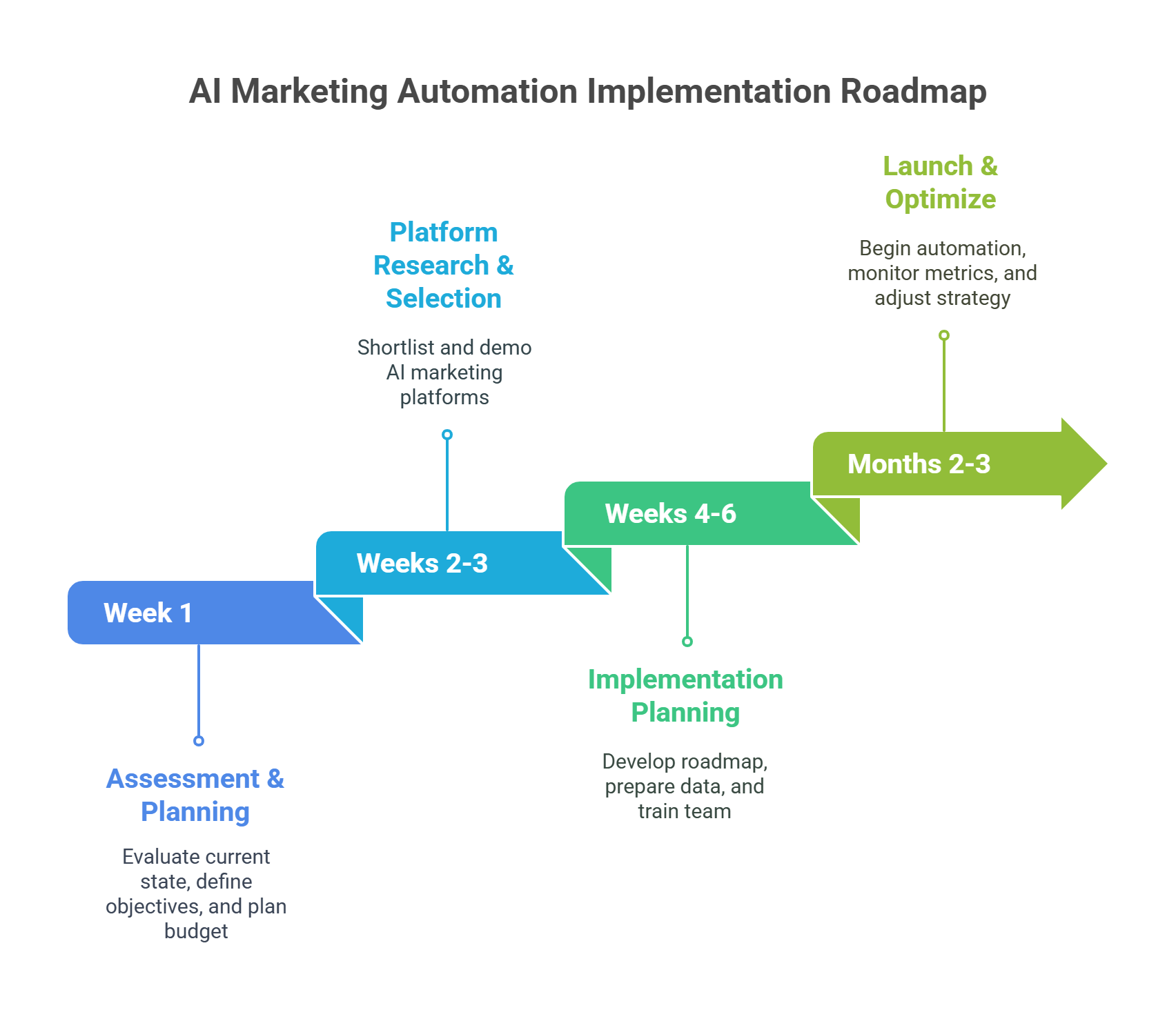
Week 1: Assessment and Planning
Evaluate Your Current State
- Audit your existing marketing technology stack
- Assess your data quality and completeness
- Identify your biggest marketing challenges and bottlenecks
- Define clear objectives and success metrics
Budget and Resource Planning
- Determine your budget for AI marketing automation
- Identify team members who will be involved in the implementation
- Plan for training and potential consulting needs
Weeks 2-3: Platform Research and Selection
Create Your Shortlist – Based on your needs assessment, narrow down to 2-3 platforms for deeper evaluation. Consider:
- Feature alignment with your specific needs
- Integration capabilities with your existing systems
- Pricing structure and total cost of ownership
- Implementation timeline and support requirements
Conduct Platform Demos – Schedule detailed demos with each vendor, focusing on your specific use cases rather than generic presentations.
Weeks 4-6: Implementation Planning
Develop Your Implementation Roadmap – Create a detailed timeline including:
- Data preparation and migration schedules
- Team training milestones
- Phased feature rollout plan
- Success measurement checkpoints
Prepare Your Team – Start training your team on AI marketing concepts and the specific platform you’ve chosen. Most successful implementations involve extensive user training before launch.
Months 2-3: Launch and Optimize
- Start Simple, Scale Smart – Begin with basic automation workflows and gradually add AI features as your team becomes comfortable and your data improves.
- Monitor and Adjust – Track performance metrics weekly and be prepared to make adjustments. AI marketing automation tools require periodic optimization to achieve optimal results.
Conclusion: Your Marketing Future Starts Now
AI marketing automation isn’t just changing how we market – it’s redefining what’s possible in customer relationships. The companies that are embracing AI marketing automation tools and other technologies thoughtfully and strategically are building significant competitive advantages over their counterparts and this will compound over time.
The question isn’t whether you should implement AI marketing automation, but how quickly you can do it effectively.
Every day you wait, your competitors are getting smarter, your customers are raising their expectations, and the gap between leaders and laggards is widening.
Hence,
Start with a clear strategy >> Choose the right platform for your needs, and remember that successful AI marketing automation is as much about the human elements – strategy, creativity, and customer empathy – as it is about the technology.
The future of marketing is intelligent, personal, and automated. The question is:
Will you be leading that future or scrambling to catch up?
Your customers are waiting for experiences that feel genuinely personal and perfectly timed. AI marketing automation tools and platforms give you the power to deliver exactly that, at scale, profitably, and consistently.
The transformation starts with your next decision. Make it count.

